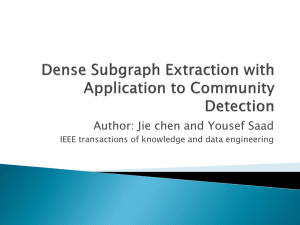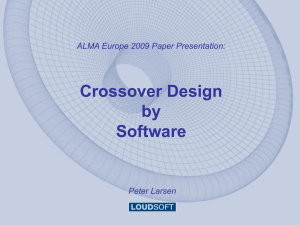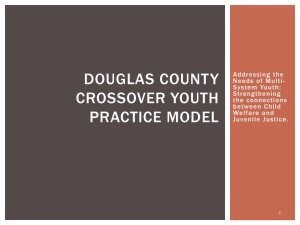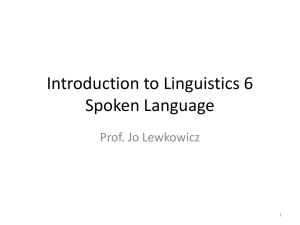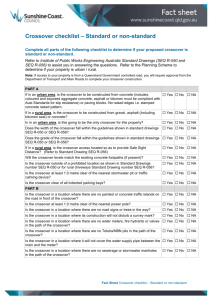Document
advertisement
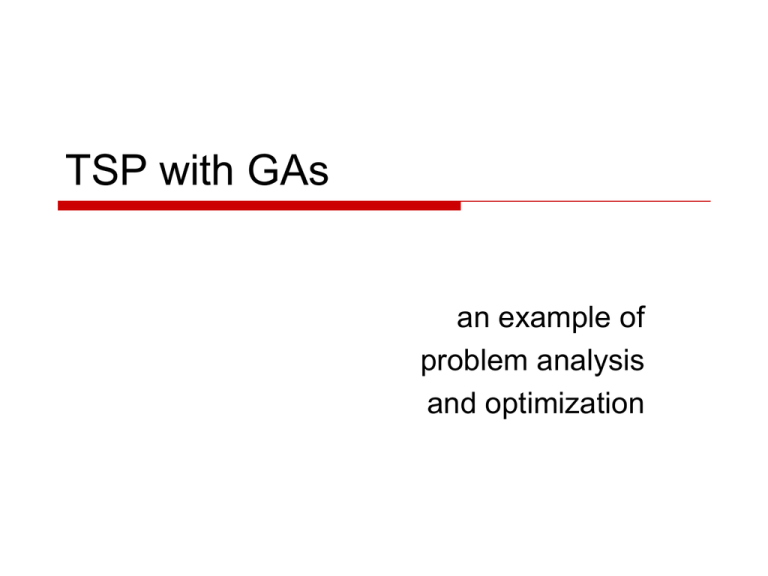
TSP with GAs
an example of
problem analysis
and optimization
TSP - by the categories
1.
2.
3.
4.
5.
representation
fitness
variation
selection
initialization
many choices
easy
many choices
augmented algorithms
Representations
TSP is a permutation problem
sequential (path)
adjacent
ordinal
boolean adjacency matrix
boolean precedence matrix
Representations
sequential (path)
3-4-6-2-5-1
adjacency
1 2 3 4 5 6
3 5 4 6 1 2
ordinal
3,3,4,2,2,1
{1,2,3,4,5,6}
{1,2,4,5,6}
{1,2,5,6}
{1,2,5}
{1,5}
{1}
3
4
6
1
5
2
3
Crossover Variations based on 1
sequential (path) representation
4
6
5
2
1
2
PMX (partially-mapped crossover)
3-4-6-2-5-1
6
1-2-3-4-5-6
5
swap segments
x-x-3-4-5-x
x-x-6-2-5-x
analysis: what is inherited?
retain where possible
parent
1
2
x-x-3-4-5-1
position?
y
y/n
1-x-6-2-5-x
relative order?
y
y/n
map from swap
adjacency?
y
n
6-2-3-4-5-1
1-4-6-2-5-3
3
4
3
Crossover Variations based on 1
sequential (path) representation
OX (order crossover)
4
6
5
2
1
2
3
6
CX (cycle crossover)
5
using complementary representations
Grefenstette’s heuristic (p.202)
ER (edge recombination)
analysis: what is inherited?
parent
1
2
position?
?
?
relative order?
?
?
adjacency?
?
?
4
3
Single parent variations on
1
sequential (path) representation
Inversion (like 2-opt)
4
6
5
2
1
2
3
6
Insertion
5
Displacement
Reciprocal exchange
analysis: what is inherited?
from parent
position
?
relative order?
?
adjacency?
?
4
3
Multi-parent variations on
1
sequential (path) representation
Herdy’s heuristic (p.201)
4
6
5
2
1
2
3
6
5
analysis: what is inherited?
from parents
position
?
relative order?
?
adjacency?
?
4
3
Crossover Variations based on
adjacency representation
Alternating edges
1 2 3 4 5 6 1 2 3 4 5 6
3 5 4 6 1 2 2 3 4 5 6 1
edge from random parent
1 2 3 4 5 6
3
repeat, random city if cycle
1 2 3 4 5 6
3 1 4 5 6 2
1-3-4-5-6-2
4
6
1
5
2
1
2
3
6
5
analysis: what is inherited?
parent
1
2
position?
?
?
relative order?
?
?
adjacency?
?
?
4
3
Variations based on
ordinal representation
classic crossover works
without repair
. . . but how good is it?
4
6
1
5
2
1
2
3
6
5
analysis: what is inherited?
parent
1
2
position?
?
?
relative order?
?
?
adjacency?
?
?
4
Representations
precedence matrix
vij = 1 if i before j, i≠j
1
0
1
1
1
2
0
0
1
1
3
0
0
0
0
4
0
0
1
0
5
0
1
1
1
6
0
0
1
1
1
2
3
4
5 1 0 0 0 0 0
6 1 1 0 0 1 0
3
4
6
1
5
2
Variations based on
1
precedence matrix representation
intersection
union
1 2 3 4 5 6
1 0 0 0 0 0 0
1 2 3 4 5 6
1 0 1 1 1 1 1
2 1 0 0 0 1 0
2 0 0 1 1 1 1
3 1 1 0 1 1 1
3 0 0 0 1 1 1
4 1 1 0 0 1 1
4 0 0 0 0 1 1
5 1 0 0 0 0 0
5 0 0 0 0 0 1
6 1 1 0 0 1 0
6 0 0 0 0 0 0
3
4
6
5
2
1
2
3
6
analysis: what is inherited?
parent
1
2
position?
?
?
relative order?
?
?
adjacency?
?
?
5
4
Representations
adjacency matrix
vij = 1 if ij is directed edge
1
0
0
0
0
2
0
0
0
0
3
1
0
0
0
4
0
0
1
0
5
0
1
0
0
6
0
0
0
1
1
2
3
4
5 1 0 0 0 0 0
6 0 1 0 0 0 0
3
4
6
1
5
2
Variations based on
adjacency matrix representation
submatrix
rearrangement
common links
1 2 3 4 5 6
1 0 0 1 0 0 0
1 2 3 4 5 6
1 0 1 0 0 0 0
2 0 0 0 0 1 0
2 0 0 1 0 0 0
3 0 0 0 1 0 0
3 0 0 0 1 0 0
4 0 0 0 0 0 1
4 0 0 0 0 1 0
5 1 0 0 0 0 0
5 0 0 0 0 0 1
6 0 1 0 0 0 0
6 1 0 0 0 0 0
3
4
6
1
5
2
1
2
3
6
analysis: what is inherited?
parent
1
2
position?
?
?
relative order?
?
?
adjacency?
?
?
5
4
Selection strategies
Incest-prevention - solutions can’t cross
over with close relatives
goal: maintain variety in population
LIKE TABU
Extending EA’s with local search
procedure evolutionary algorithm**(p.215)
t <-- 0
initialize P(t) // population
local-optimize(P(t))
while (~termination-condition) do
t <-- t+1
P’(t) <-- alter(P(t-1)) // offspring
local-optimize(P’(t))
P(t) <-- select (P’(t), P(t-1))
end
end
(I have revised this algorithm)
interpretation
procedure evolutionary algorithm**(p.215)
t <-- 0
initialize P(t) // population
local-optimize(P(t))
while (~termination-condition) do
t <-- t+1
P’(t) <-- alter(P(t-1)) // offspring
local-optimize(P’(t))
P(t) <-- select (P’(t), P(t-1))
end
end
populations are locally optimized
alterations produce ‘infeasible’ (not locally
optimal) solutions that are repaired by local
optimization
example: Muhlenbein, p.215
OX (order crossover) and 2-opt local optimization
Edge assembly crossover (EAX)
Extended EA algorithm
1. expensive crossover with local optimization
heuristic (variation)
2. repeatedly used with same parents looking for
a child better than both (locally optimized
selection)
Edge assembly crossover (EAX)
Extended EA algorithm
1. expensive crossover with local
optimization heuristic (variation)
3
4
4
6
1
5
3
4
6
6
2
5
4
5
3
3
6
1
1
5
2
2
1
2
Edge assembly crossover (EAX)
Extended EA algorithm (p.217)
2. repeatedly used with same parents looking for a
child better than both (locally optimized selection)
3
4
4
4
6
6
1
5
2
3
4
4
4
2
4
5
3
6
5
3
5
3
5
3
1
23
1
23
1
2
1
6
5
6
1
5
6
5
6
1
4
6
2
2
1
2
The champion TSP algorithm:
Inver-over operator
procedure inver-over
initialize P
while not done
for each Si P
S’ <-- inver-over-op(Si)
if (eval(S’) ≤ eval(Si))
Si <-- S’
Inver-over operator
Asymmetric multi-parent operator
inver-over-op(Si)
S’ <-- Si
c <-- random city from S’
repeat
if (rand() < p)
select c’ from S’, c’≠c
else
select Sj, Sj ≠ Si
c’ <-- city next to c in S’
do 2-opt swap between c, c’ in S’
c <-- c’
until c’ follows c in Si
return S’
Inver-over
S’: 3-7-2-5-1-6-4
c <-- 2
p?
c’<--6S’
S’:3-7-2-6-1-5-4
c <--6
2 new edges
inver-over-op(Si)
S’ <-- Si
c <-- random city from S’
repeat
if (rand() < p)
select c’ from S’, c’≠c
else
select Sj, Sj ≠ Si
c’ <-- city next to c in S’
do 2-opt between c, c’ in S’
c <-- c’
until c’ follows c in Si
return S’
c’<--1 Sj: 7-4-6-2-1-5-3
S’: 3-7-2-1-5-6-4
c <--1
1 inherited edge
1 new edge
